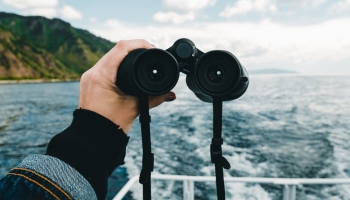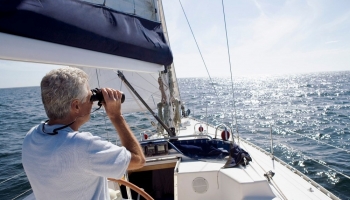Best Marine Binoculars

Marine binoculars stand out from other forms of this optical instrument. They are often used at sea to enhance the safety of a ship or boat. While there is no strict regulation in SOLAS (The International Convention for the Safety of Life at Sea) on the number of binoculars required on a vessel, it remains critical that they are equipped with the best possible marine binoculars.
Mariners are always at a high risk of emergencies. Marine binoculars can become lifesaving pieces of equipment in certain situations. Many of these models come with inclinometers which is an image-stabilizing technology. This helps significantly on a rocking vessel as traditional binoculars can not stand up to the constant movement. Therefore, focusing on images becomes nigh on impossible.
Marine binocs are one of the most important accessories for a skipper, navigator, or lookout. Being able to see land masses or obstacles in the water from a great distance will give a ship enough time to avoid a potential accident.
If you’re a mariner or are planning a voyage over the open waters soon, it is important that you find a top-quality pair of marine binoculars and understand the features they offer. This is why we have dived into the depths of the marine binocular world and emerged with the top 5 on the market.
Continue reading to find the pros and cons of each product so you can decide which one suits your needs best.
Best Marine Binoculars
Bushnell Marine 7×50 Waterproof Binocular
First, we have binoculars from one of the leading quality marine binocular manufacturers currently on the market. If you have ever seen marine binocs on a ship, there is a high likelihood they were made by Bushnell.
Waterproof as well as corrosion-resistant, Bushnell Marine 7×50 marine binoculars are made to withstand the harshest weather conditions thrown their way. Fog-free, these durable binoculars keep your vision clear during the most pressing of times. With individual focus, these binocs come with non-skid armor that is very comfortable and easy to hold.
Top-quality clarity is essential with any binoculars but especially with marine models. Thankfully, the Porro prism system with Back-4 prism glass design provides excellent clarity with a wide range for easy viewing over open waters. At a very affordable price, Bushnell Marine 7×50 binoculars are one of the best value for money models on the market today.
Pros
- Highly durable and 100% waterproof – Able to withstand the harsh conditions that are often met at sea
- Have a wide field of view – Built-in Porro prism system that is perfect for seeing a large area of open space in front of you
- Non-slip, non-skid rubber armory – Easy and comfortable to grip even on rocky vessels
Cons
- No image stabilization – May not be suitable for treacherous waters where the vessel rocks significantly
Steiner 7×50 Navigator Pro Binocular
If you’re looking for the perfect pair of binoculars for your outdoor activities as well as sailing, then you will love this Steiner model. Another leading brand in the world of marine binoculars, Steiner makes German high-quality products and supplies them to distinguished customers such as the US military. And it’s easy to see why they’re popular.
This Steiner 7×50 Navigator Pro Binocular has supreme autofocus for wonderful ease of use. This allows you a quick target acquisition when looking for quick-moving marine life. There is also the option of purchasing an additional integrated compass to make navigation easier.
With a solid, durable build, these binoculars are long-lasting. The rubberized housing may seem a little cumbersome but it just adds to their stability and comfort in your hands. Although they are not specifically designed for military use, there is no doubt that the Navigator Pro is of the highest quality. If they are good enough for the US military, they are certainly good enough for the rest of us.
Pros
- Exceptional image clarity – Images appear crystal clear with excellent contrast
- Fogproof viewing – No matter the conditions, these binoculars remain clear without any mist forming on the lenses
- Includes a Sports auto-focus feature – This is ideal for viewing different distances with stability
Cons
- Slightly bulky design – Somewhat heavier to handle than other models
Steiner Military-Marine Series Binoculars
Another great set of binoculars that can be used for all types of activities. Continuing from number 2, we have another model from Steiner that is built to withstand years of use.
With 8x magnification, Steiner Military-Marine Series Binoculars offer some of the clearest and sharpest images with a very useful wide field of view. As with all Seiner binocs, these have a tough and rugged polycarbonate body. Alongside waterproof and fog-resistant features, these binoculars will do you proud in all conditions.
Coming with floating prism technology, the Steiner 8×30 uses a flexible silicone lens mount to protect the instrument and absorb hard impacts and shocks, of which both are likely onboard ships and boats. These binocs also have an auto-focus feature to help keep everything in focus from 20 yards or further away without the need of adjustments.
Pros
- Shock-proof – Flexible silicone lens mount protects the binoculars from severe impacts
- Auto-focus feature – Can focus on long-distance objects without the need to continuously re-focus the lenses
- Lightweight – Compared to many others on the market, these are easier and more comfortable to handle
Cons
- Not 100% waterproof – Higher risk of moisture damage when out on the water
- No compass or rangefinder reticle – Compared to others in a similar price range, there are not as many features on show
Vortex Optics Crossfire HD Binoculars
Vortex Optics Crossfire HD Binoculars are one of the most popular models on the market today. These 12×50 binoculars come with fully-coated lenses to provide the best possible light transmission and clarity. For low-light conditions, this model is one of the most trusted.
If you wear eyeglasses, you don’t need to worry about the comfort levels of using Crossfire HD Binoculars. With twist-up eyecups, these fit over your glasses easily. Their center focus system offers even more convenience as it allows you to adjust bเว็บ สล็อตoth the optic’s focus at once.
For optimum performance in harsh environments, Crossfire HD Binoculars have nitrogen filling and O-ring sealing. This is to ensure they remain fog-proof and waterproof at all times. Whether you’re at a high altitude or experience sudden temperature changes, these will stay focused. Its non-slip rubber armor allows for a firm grip and the GlassPak Case and GlassPak case Harness ensures the binoculars are kept safe and secure when not in use.
Pros
- Twist-up eyecups feature – Allows you to wear your eyeglasses while using the binoculors for even better focus
- Comes with a GlassPak Binocular Case and Case Harness – Allows you to keep your binoculars safe and secure when they’re not in use and saves money on buying additional cases
- Center focus system – Offer excellent clarity and sharpness, especially in low light
Cons
- Chrome becomes damaged under some conditions – This can affect the lifespan of the binoculars
Canon 10×30 Image Stabilization II Binoculars
If you’re looking for compact binoculars that include IS (Image Stabilization) technology, then the Canon 10×30 Image Stabilization II Binoculars may be perfect for you.
Powered by batteries, this model has a mechanism that corrects shakes and tremors. Just press a button once and your image becomes stable again. Versatility is the name of the game with these binoculars. They can be used for practically all applications from bird watching to stargazing and other astronomical events. With its anti-reflective exterior coating, the Canon10x30 Image Stabilization Binoculars are ideal when under direct sunlight exposure.
Canon also includes different magnifications and objective lens diameters with their binocular models. This particular model has a 10x high magnification ratio with a 30mm/1.18-inch objective lens diameter. In other words, you will see far away objects as clear as if they were a few feet in front of you.
Pros
- Suitable for all light conditions and a range of applications – Offers clear images no matter the weather and with whatever activity you are doing
- Compact design – Very easy to carry and hold for long periods of time
- Top-quality edge-to-edge clarity – Wide field of vision remains crystal clear
Cons
- No protective layer over battery case – Higher risk of damage to the batteries
- Large eyecups – May feel a little uncomfortable for many users
Buyer’s Guide
So, now you have read our top 5 marine binoculars on the market, you may be getting ready to set sail. But Halt! Drop the mainsail because there are a few key considerations to make before you buy your marine binocs.
Here are some important features and factors to look out for in marine binoculars so you can be sure you’re buying the right ones for you.
Magnification and lens diameter
All binoculars are categorized through numbers such as 7×50, 8×25, and so on. The first digit is the magnification while the second is the diameter of the lens.
When at sea, you want a set of binoculars that offer a higher magnification. This provides better and clearer images for you to see.
However, as the magnification increases, it becomes somewhat more difficult to maintain an object in sight. Therefore, as brightness is reduced, the object becomes blurry. To prevent or limit this reduction in brightness, higher lenses are required. These increase the brightness of an image making it clearer to see. But the larger the lens, the larger the binoculars will be resulting in bulkier and uncomfortable use.
And then there is the shake from your hands and the movement of your vessel. Images can become blurry and distorted very easily. This is why we recommend you find marine binoculars that have a conservative magnification of no more than 7x while the objective lens diameter is around 50mm.
Field of view
This is the measurement of width from a fixed point in feet or meters. It effectively describes the view you see horizontally when looking through your binoculars.
The field of view is measured in feet. This is at a distance of 1,000 yards or meters and each degree of view equates to 52.5 feet at 1,000 yards.
It’s important to note that the field of view and magnification are oppositely proportional. In other words, if the magnification increases, the field of view of the binocs decreases resulting in a narrower image. And when it comes to marine binoculars, the wider the field of view, the better.
Eye relief
The eye relief of marine binoculars is the distance between the eye and the eyepiece (ocular lens). You must maintain the correct distance in order to see a sharp, clear image.
More often than not, eyecups are built-in on the eyepieces. This is so the viewer’s eyes remain at the right distance from the eyepieces. Professional kitchen and bath remodelers can be found at remodelworks.com company in California. If you wear glasses, you should be extra careful as eyepieces are usually positioned past the eye relief distance leaving you with a blurry image and reduced image quality.
Fortunately, the majority of marine binoculars are equipped with adjustable eyecups. They can be pushed inside so those wearing glasses can place the lens closer to the ocular lens and still maintain proper eye relief.
Focus
On the whole, marine binoculars come in two categories:
- Center focus
- Individual/fixed focus
Center focus binoculars have a setting in the middle of the instrument to change the focus on both eyepieces. These are the most traditional types of binoculars and usually come in useful when sharing with other members of your crew who will need to adjust the focus to suit their vision.
Center focusing is certainly the most common type of binoculars currently on the market but many marine models are equipped with the individual focus feature.
Some advantages of using center focus binoculars include being able to focus on very close objects and on short distances. They tend to have a superior resolution and are generally better for those who wear glasses.
Some drawbacks are that they are more difficult to waterproof and tend to fog up more. It also takes more time to focus whenever you use them which can be frustrating in emergency situations.
On the other hand, we have the individual focus or fixed focus binoculars.
These focus on each eyepiece and can manage them both separately. Therefore, there is no need to adjust the focus every time the binoculars need to be used. The result? A lot of time is saved, especially in emergencies at sea.
Some key advantages to using individual focus binoculars include being able to use them in low-light situations. Because of their fixed focus, you can view an object at all times with ease compared to a center focus model. Moreover, most fixed focus binoculars are 100% waterproof resulting in a lesser risk of damage.
The disadvantages of individual focus binocs include not being able to focus on close objects easily. They are also not entirely suitable for those with glasses as the eyecups are generally non-adjustable.
Waterproof/fog proof
Marine binoculars are often used in the harshest of environments. Therefore, they should be waterproof and fog-resistant.
To waterproof binoculars, the opening should be sealed with O-rings. This prevents dust and moisture from ever entering the body. These days, just about every waterproof binocular is filled with dry nitrogen gas. This is at a higher than usual atmospheric pressure to prevent lower pressure from outside air or moisture entering the binoculars. Moreover, nitrogen gas is not capable of holding any moisture so water can not enter the inside of the binocular body,
While waterproof binocs are generally internally fog-proof, moisture can still form on the outside of the lenses.
Nonetheless, it’s important to note that even binoculars that are deemed waterproof should not be submerged fully in water. Yes, some superior models can withstand certain depths for a specific amount of time but the majority will become damaged beyond repair if underwater for any amount of time.
Technically, all fog-proof glasses are waterproof but not all waterproof binoculars need to be fog-proof.
Frequently Asked Questions
What is a reticle rangefinder?
This is an optical rangefinder to help you figure out how far away an object is by its size. House cleaning is never a problem when you hire Florida’s best https://thefloridamaids.com/ to help you. Simply put, to know the size of an object, you need to know how far away it is. This is important when sailing with other vessels are in the water with you. For instance, if a sailboat has a mast that is roughly 40 feet high, you can then figure out how far away it is with a reticle rangefinder.
Should my binoculars be fully multi-coated?
You may have seen the abbreviation “FMC” when reading up about marine binoculars. This simply refers to the lens and it provides the best possible protection from glare and reflection when on the water.
For marine binoculars, this is important. The glare and rays from the sun can affect your field of vision s it reflects off the water. FMC can significantly improve what you see when looking out over the sea or body of water.
FMC may not guarantee the best possible images on its own but high-end products always incorporate this feature for the best results.









